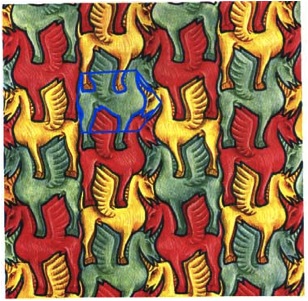So tessellations have always intrigued me so I figured my first tutorial post I’d post about them!
I did this as one of my senior art projects in college and really enjoyed doing it mostly because of my math background (I have a BA in Math Education and a minor in Art Education.)
First, what the heck is a tessellation?
o Oxford American Dictionaries definition: Mathematics, cover (a plane surface) by repeated use of a single shape, without gaps or overlapping.
o Short Tessellation history.
Tessellations are thousands of years old and can be found all over the world in a variety of cultures and in a variety of forms. They can be traced all the way back to the Sumerian civilization (about 4000 B.C.) in which the walls of homes and temples were decorated by designs of tessellations constructed from slabs of hardened clay. Not only did these tessellations provide decoration but they also became part of the structure of the buildings. Since then, tessellations have been found in many of the artistic elements of wide-ranging cultures including the Egyptians, Moors, Romans, Persians, Greek, Byzatine, Arabic, Japanese, and Chinese. (History taken from http://library.thinkquest.org/16661/history.html)
OK now on to the fun stuff. There are 3 different types of tessellations, or in other words you can tessellate in 3 different ways.
Rotating
 |
| This is not an example of my own, but one I found online through google. |
Flipping/Mirroring (this one also uses a little sliding)
 |
| This is not an example of my own, but one I found online through google. |
Sliding
 |
| This is not an example of my own, but one I found online through google. |
Today I just wanted to show you one. Maybe later I’ll show you how to do the other two. Although I have not created a Flipping/Mirroring one on a grand scale like the other two yet.
 |
|
Using a piece of graph paper, apply tape to make it slightly thicker, this will help later when tracing the shape. You’ll want graph paper for the grid, it’ll help you later on.
|
 |
| This is what the back will look like. |
 |
|
1. Next draw a design on the square that connects to the sides. (I drew two shapes on this on since it was the beginning to save time).
|
 |
|
Cut out the shape and transfer directly across the square lining up the lines on the graph paper. Ex: the first shape I cut from the bottom side, so I’ll transfer to the opposite side, the top.
|
 |
|
Now you can draw another shape adding more of a variety to your overall image.
|
 |
|
I kept going with a few more shapes.
|
 |
| This is what my finished piece looked like. |
 |
| This is what is should look like when you are done tracing. |
 |
| I used watercolors, but any medium will work that can work in detail, colored pencils, painting… whatever |
 |
| Finished painting! |
 |
| Matted! |
 |
| Here is a ROTATING one I made for my corporative teacher. She picked the colors and it turned out great! |
Eventually I’ll post on how to make a rotating one as well as a flipped/mirror image one.
We would love to see your tessellations!
Send us and email! kreativ77@yahoo.com












